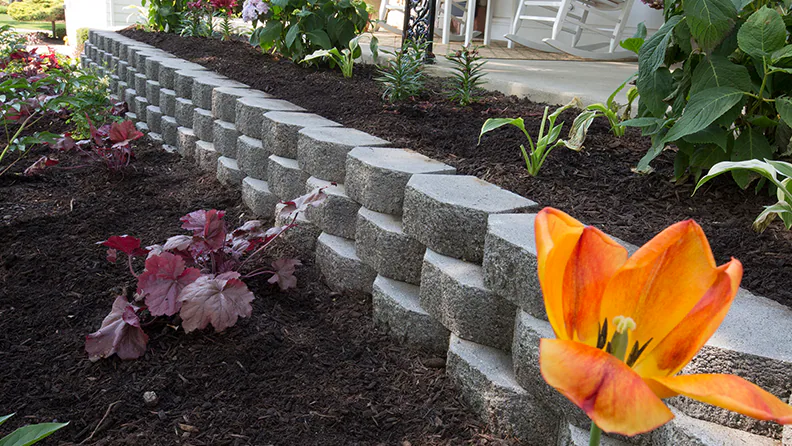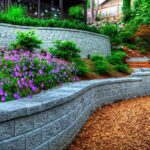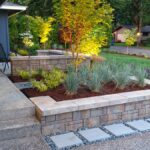Retaining walls are a popular landscape component commonly added to landscaping designs in front and back yards.
Since they are used for multiple purposes, it is important that retaining wall installation is done by an experienced contractor who uses the proper methods to build a strong, structurally sound support.
Below, learn where these walls might be used and the methods used by retaining walls contractors in Minneapolis, MN to solve various landscaping problems.
What Do Retaining Walls Do?
Retaining walls built into a landscape or property design serve four main purposes:
- Aesthetic Containment – Low walls are commonly used around planted beds and landscape features to contain bedding material and simply look nice.
- Prevent Soil Erosion or Collapse – Retaining wall installation is one of the numerous solutions for preventing soil collapse and erosion due to gravity in places where there are ground elevation changes or where spaces for paths, patios, walkways, driveways, and more are cleared away leaving higher ground in need of support.
- Direct Water Drainage – Retaining wall contractors might also install a support structure to control the flow of rainwater, further protecting the soil from being damaged by erosion.
- Provide Extra Seating – Walls constructed as boundaries around patios and landscape features can serve additionally as attractive, inconspicuous seating that blends right in with the design.
What Retaining Walls Are Installed For These Purposes?
Though many people think that a retaining wall consists of little more than a row of stacked bricks or fieldstone, this is not so.
Depending on the degree of support the wall must provide, the location, and many other details about the topography of the building lot, retaining wall contractors must use an installation method that ensures the structure is strong enough to perform its job:
- Gravity Walls – The most basic of all retaining walls, these are made simply of stacked stones, bricks, pavers, and other options to stay up simply through gravity and their own weight. These walls are most useful for decorative purposes around planted beds and in places where erosion and drainage issues are not a concern.
- Piling Wall – A structure made of steel, wood, or vinyl pilings driven directly into the ground, these retaining walls are useful where ground support is required to prevent shifting or erosion caused by gravity.
- Cantilever Wall – Strong, supportive retaining wall installations that incorporate a cement or other material support that is buried at the base to provide structural integrity to the ground, which is filled in behind it. The front of the support can then be decorated as desired with brick, stone, and other materials.
- Anchored Wall – Anchored retaining walls are those that require additional structural support in the form of ground anchors which are inserted through the support material and into the ground behind it to keep the wall upright against the ground it is stabilizing. As with the cantilever wall, an anchored design can then be decorated appropriately to hide the structural part of the wall and blend in with the rest of the landscape design.
Always Hire An Experienced Retaining Walls Contractor!
Retaining wall installation can be an aesthetic improvement for any property, a structurally protective one, or both.
The key to getting a correct installation that uses the right method based on ground qualities and the main purpose of even putting up a wall is hiring the right experienced contractor to do it.
When hiring a retaining wall contractor in Minneapolis, MN, be sure to discuss the different types of structural support they recommend for the application and why to make an informed decision that will result in a durable, long-lasting wall!
Considering Retaining Walls in Minneapolis, MN ?
Green Grounds Landscaping Are Pros at Retaining Walls Work! Call 612-408-4796 To Discuss Your Needs!









